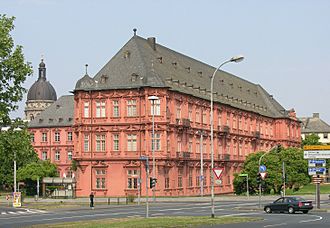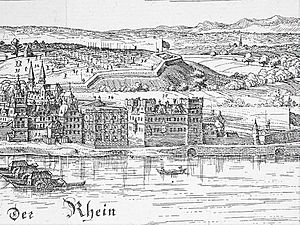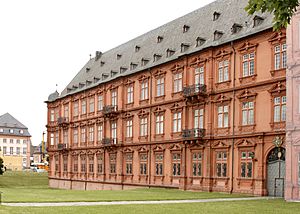Electoral Palace, Mainz facts for kids
Quick facts for kids Electoral Palace |
|
|---|---|
|
Kurfürstliches Schloss
|
|

Southeast façade of the Electoral Palace
|
|
| General information | |
| Architectural style |
|
| Town or city | Mainz |
| Country | Germany |
| Coordinates | 50°00′24″N 8°16′14″E / 50.00667°N 8.27056°E |
| Named for | Prince-elector and Archbishop of Mainz |
| Construction started | 1627 |
| Completed | 1752 |
| Design and construction | |
| Architect | Matthew of Saarburg |
The Electoral Palace in Mainz is a very old and important building in Germany. Its German name is Kurfürstliches Schloss zu Mainz. Long ago, it was the home of the Prince-elector and Archbishop of Mainz. This person was a powerful leader who was both a prince and a church leader. The palace is a great example of Renaissance style.
Contents
Why Was the Palace Built?
The Archbishop of Mainz used to live at the cathedral. But in 1475, a new rule was made. The Archbishop had to build a castle in the city. This new castle was called Martinsburg. Its building started in 1478 and finished just two years later.
For many years, the archbishops lived in Martinsburg. They also sometimes stayed at another palace in Aschaffenburg. Martinsburg was damaged in a war in 1552. It was then fixed up in the Renaissance style. Later, some other buildings around it were built. Sadly, these buildings and Martinsburg were torn down by Napoleon much later. This happened when the French controlled the town between 1798 and 1814.
Building the Electoral Palace
Building a brand new palace began in 1627. This was ordered by Archbishop Georg Friedrich von Greiffenklau. The part of the palace facing the Rhine River took a long time to finish. It was not ready until 1678. Building was slowed down by two big wars. These were the Thirty Years War and the War of the Grand Alliance.
The original plan for the palace is not fully known. It was probably meant to have four wings. This was similar to another palace built in 1604. The old Martinsburg castle likely stayed standing only because of these delays.
The north wing of the palace started being built in 1687. It was ready by 1752. The inside was decorated in the years that followed. Work on the wing going away from the river began later. This happened when Johann Friedrich Karl von Ostein and Friedrich Karl Josef von Erthal were archbishops.
Building was also slow because the leaders were building other things. For example, the Lustschloss Favorite was started in 1700. This summer home used up a lot of money and workers. That beautiful summer palace was destroyed in 1793. It was hit by bombs during the Siege of Mainz.
Changes and Challenges
On October 23, 1792, an important political group was formed. It was called the Jacobin Club. This group was part of the French Revolution. It was the first time a democratic movement started in Germany. Archbishop Erthal was the last Prince-Elector of the old area. He was forced to leave the city in 1792.
His replacement, Karl Theodor von Dalberg, became Archbishop-Elector. But his main office moved to Regensburg. The palace in Mainz was then left empty for a while. In 1827, it was fixed up by the Grand Duchy of Hesse-Darmstadt and the City of Mainz.
During World War II, the palace was badly damaged. This happened especially in an air raid on February 27, 1945. Most of the city was destroyed then. Only the outside walls of the palace were left. It was rebuilt between 1948 and 1949. The palace reopened on December 31, 1949. For many years, it was the main place for Karneval celebrations. This continued until a new hall opened in 1968.
Palace Architecture
The Electoral Palace is a great example of German Renaissance architecture. It is one of the last buildings built in this style in Germany. Even the north wing, which was built later, matches this style.
The outside of the palace is very fancy. It has small turrets at each corner. The areas around the windows are richly decorated. The roofs have been carefully rebuilt to look exactly as they did before. Inside, there was once a grand staircase. It was designed by a famous architect named Balthasar Neumann. But this amazing staircase was removed when the French controlled the city.
What Is It Used For Today?
Today, the east wing of the palace is home to the Römisch-Germanisches Zentralmuseum. This museum shows many old items. You can see copies and real artifacts from prehistoric times. It also has items from the Roman Empire and the early Middle Ages. It gives a full picture of how people lived long ago.
The north wing has a famous hall. This hall is where the yearly Mainz carnival TV show is broadcast. The show is called Mainz bleibt Mainz, wie es singt und lacht. The Electoral Palace is now one of eight places managed by Congress Centrum Mainz. It has seven large halls and many smaller rooms. This allows it to host events for up to 1,700 people.
See also
- Electoral Palace, Koblenz
- Electoral Palace, Trier



